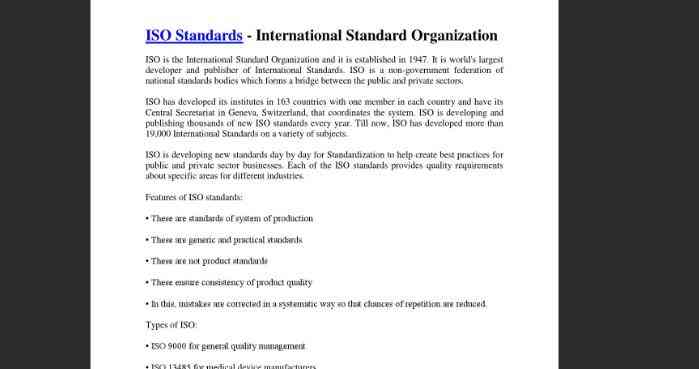|
U DC 621.795
IS0
I N TERN AT1 ON AL ORGANIZATION FOR STA N DA RDl ZATl ON
IS0 RECOMMENDATION
R 468
SURFACE ROUGHNESS
1st EDITION
February 1966
COPYRIGHT RESERVED
IS0 Standards
The copyright of IS0 Recommendations and
belongs to IS0 Member Bodies. Reproduction of these
documents, in any country, may be authorized therefore only
by the national standards organization of that country, being
a member of ISO.
For each individual country the only valid standard is the national standard of that country.
Printed in Switzerland
Also issued in French and Russian. Copies to be obtained through the national standards organizations.
---------------------- Page: 1 ----------------------
BRIEF HISTORY
The IS0 Recommendation R 468, Surface Roughness, was drawn up by Technical Com-
mittee ISO/TC 57, Surface Finish, the Secretariat of which is held by the Gosudarstvennyj Komitet
Standartov, Mer i Izmeritel’nyh Priborov pri Sovete Ministrov SSSR (GOST).
Work on this question by the Technical Committee began in 1954 and led, in 1957, to the
adoption of a Draft IS0 Recommendation.
This first Draft IS0 Recommendation (No. 221) was circulated to all the IS0 Member
Bodies for enquiry in September 1958. As the results of this consultation were not considered
satisfactory, the Technical Committee presented a second Draft IS0 Recommendation, which
was circulated to all the Member Bodies in April 1962 and which was approved by the following
Member Bodies :
Austria Greece Poland
Belgium Hung a r y Republic of South Africa
Romania
Brazil India
Switzerland
Bulgaria Israël
Burma Italy U.S.A.
Czechoslovakia Mexico U.S.S.R.
Denmark New Zealand Yugoslavia
Eight Member Bodies opposed the approval of the Draft:
Japan U.A.R.
Canada
France Netherlands United Kingdom
Germany Sweden
The second Draft IS0 Recommendation was then submitted by correspondence to the IS0
Council, which decided, in February 1966, to accept it as an IS0 RECOMMENDATION.
-2-
---------------------- Page: 2 ----------------------
lSO/R 488 - 1- (E)
IS0 Recommendation R 468 February 1966
SURFACE ROUGHNESS
INTRODUCTION
The purpose of this IS0 Recommendation is:
- to define the basic terms relating to surface roughness (section 1);
- to give a method of quantitatively evaluating the roughness of the effective profile
of a surface in accordance with the mean line system M (section 2).
Definitions and parameters in other reference systems, in particular the envelope line system E*,
will be the subject of further sections to be published subsequently in the form of addenda
to the present IS0 Recommendation.
1. GENERAL TERMS
1.1 Real surface. The surface limiting the body, separating it from the surrounding space.
1.2 Geometricalsurface. The surface determined by the design or by the process of manufacture,
neglecting errors of form and surface roughness (see Fig. 1).
NOTE. - The terms “ideal geometrical surface”, “design form” and “nominal surface” are used in certain
national standards with the sense of “geometrical surface”, as defined above.
1.3 Effective surjke. The close representation of a real surface obtained by instrumental means
(see Fig. 1).
NOTE. - The term “measured surface” is used in certain national standards with the sense of “effective
surface”, as defined above.
1. Geometrical surface
2. Effective surface
3. Geometrical profile
4. Effective profile
FIG. 1
*The difference between the M and E systems lies in reference being made to two distinct lines for
measuring the ordinates characterizing the roughness of each point of the surface profile, the criteria of rough-
ness being defined with reference to the mean line in the M system and with reference to the envelope line in
the E system.
-3-
---------------------- Page: 3 ----------------------
lSO/R 468 - 1986 (E)
1.4 Realprofile. The contour that results from the intersection of the real surface by a plane
conventionally defined with respect to the geometrical surface.
1.5 Geometricalprofile. The contour that results from the intersection of the geometrical surface
by a plane conventionally defined with respect to this surface (see Fig. 1).
NOTE. - The terms “ideal geometrical profile”, “design profile” and “nominal profile” are used in certain
national standards with the sense of “geometrical profile”, as defined above.
1.6 Effective profile. The contour that results from the intersection of the effective surface by
a plane conventionally defined with respect to the geometrical surface (see Fig. 1).
NOTE. - The term “measured profile” is used in certain national standards with the sense of “effective
profile”, as defined above.
Reference line. A line chosen by convention to serve for the quantitative evaluation of the
1.7
roughness of the effective profile.
1.8 Irregularities. The peaks and valleys of a real surface.
Surface roughness. All those irregularities of the surface which are conventionally
...














